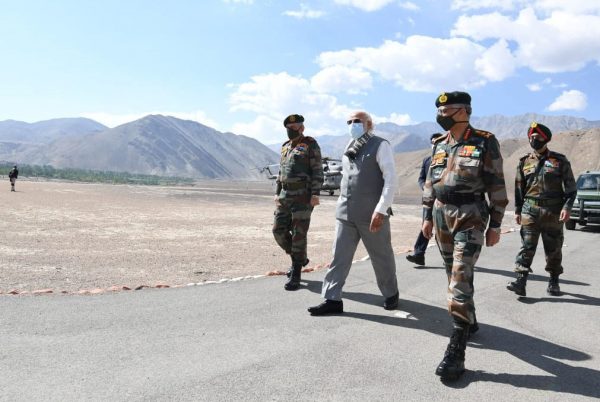Leaders on both sides have avoided escalation but there is little ballast in the relationship that gives confidence in calming tensions. The Himalayas that separate the two countries are a big buffer, with the terrain making it difficult to drive tanks over or assemble large forces, as Hugh White reminds us. But that won’t stop the relationship from deteriorating further.
This conflict may mark a critical turning point in Sino-Indian relations. It may further drive the world’s two most populous countries apart or it could be a catalyst for a more constructive future.
With both countries dealing with the health and economic crises from COVID-19, the climate is ripe for stoking nationalism and raising the tensions. Prime Minister Modi has walked India back from the brink but is still under huge pressure to retaliate somehow.
For India to achieve the vision of its rightful place in a multipolar world, Delhi will have to find a way to accommodate China and this border clash may yet force the action that’s needed.
The presumption of hostility towards China casts the Chinese economy as a massive threat to India’s. It is five times the size of the Indian economy and as India’s trade deficit continues to grow, much of it appears to derive from China’s competitive power. The real cause, of course, is India’s appetite for foreign savings to finance growth. But trade deficits, including that with China, have become in the new Indian nationalist conception — articulated after Modi and his Bharatiya Janata Party’s electoral victory in May that brought in a rare absolute majority — the central reason for the shift back to a ‘self-reliant’ India after three decades of gradual opening up.
The Indian economy is almost the same size as the 10 ASEAN economies combined and, although the Southeast Asian grouping is far from acting in unison, their economies have embraced and benefited from China’s rise. India appears cowed by it. Yet to be internationally competitive, Indian firms need to compete, not to be sheltered from embracing integration with the international economy including that of China.
In this week’s lead essay, Suman Bery and Alicia Garcia-Herrero argue that ‘India has the scale and sophistication to recalibrate its economic relationship with China such that deeper interdependence reduces, rather than increases, New Delhi’s economic vulnerability’.
The path to power, prosperity and security is not economic retreat and ‘economic retaliation’ that costs the Indian people and makes them poorer and India smaller. It requires proactive engagement, alongside Australia, Japan, Vietnam and the rest of Southeast Asia with China, not isolation from it.
The Regional Comprehensive Economic Partnership (RCEP) agreement is politically radioactive in India, just as the Trans-Pacific Partnership (TPP) was for many countries in the East Asia and Pacific, and ultimately for its central proponent, the United States itself. Many in India believe that RCEP is China-led and signing up to it will decimate Indian industry. But RCEP is an Indonesian and ASEAN-led agreement that was created to manage Southeast Asia’s relations with their large neighbouring economic powers.
The conception of RCEP as a China agenda is a totally incorrect perception of its origins and strategic purpose — RCEP is and was from the beginning an ASEAN agenda for dealing with China and the regional economic powers in a multilateral setting.
It was political pressure, including riots, that forced Modi to walk away from the deal in Bangkok last November at the 11th hour after his negotiators had done pretty much all the hard work and the agreement was there for the taking.
Retreat from RCEP due to fear of the Chinese economy is a missed opportunity. Failure to engage in RCEP foregoes the opportunity to leverage regional weight in economic dealings with China and the opportunity to balance and engage with China with the support of ASEAN, Japan, China, Korea, Australia and New Zealand.
RCEP or no RCEP, India still has to deal with China. Without RCEP, India will have to deal with China alone, bilaterally. In asymmetric bilateral economic dealings, the smaller power, as for decades India will remain, deals at a natural disadvantage.
RCEP provides a multilateral framework allowing India to rely on stronger rules in its economic dealings with China and others in East Asia, as with the rest of East Asia. It would also allow India to shape the principles and norms of engagement through an active economic cooperation agenda.
Above all else, failure to engage in RCEP undermines Indian relations with ASEAN, at RCEP’s strategic core.
India is at a choice point. It’s a large power that can remain one-fifth of China’s size by closing up its economy. Delhi can back President Trump’s plan for a new template of retreat from globalisation and decoupling from China. That’s a template likely to lead to a return to the 1930s.
Or India can choose to engage multilaterally to build its international competitiveness and multipolar space protected by robust rules and the leverage to enforce them with others.
The open road would have Prime Minister Modi seize a Nixonian moment. No leader has been willing to brave the deep anti-China sentiment in India and take steps needed to build a constructive relationship. So one of the world’s most consequential relationships is still governed through the prism of the baggage of territorial history — predominantly defined by the long-running border dispute between them.
Can Indian leaders and strategists really grasp the vision of an India that can out-compete China internationally with cheaper labour and its innovation and IT potential and a world in which both India and China can be better off and constructively engaged politically? Maybe Mr Modi can yet seize the moment.
The EAF Editorial Board is located in the Crawford School of Public Policy, College of Asia and the Pacific, The Australian National University.

